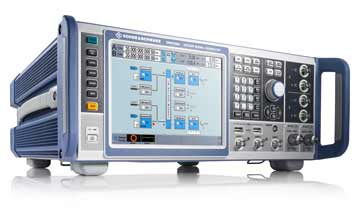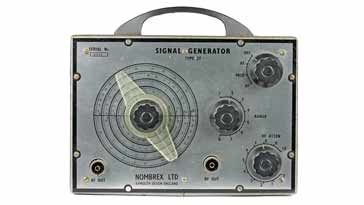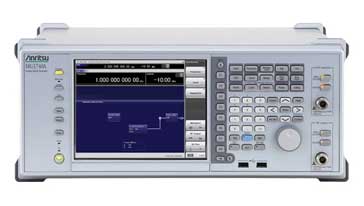RF Radio Frequency Signal Generator
Radio Frequency, RF or microwave signal generators are used to provide a stimulus for many RF circuits.
Signal Generators includes:
RF signal generator basics
RF signal generator specs
Signal generator types: Signal Generator Basics Arbitrary waveform generator Function generator Pulse generator
Radio frequency, RF signal generators are an essential item of test instrumentation for any area where RF or microwave test and development is undertaken.
A microwave or RF signal generator provides a signal source that can be used to test the operation of the circuit being tested or developed. Unlike many other items of test equipment, the signal generator does not make any measurements, but provides the right test conditions for other items of test instrumentation to measure the output signals from the unit under test.

The purpose of the signal generator is to generate a signal with known characteristics: frequency, amplitude, modulation and the like. It is therefore possible to look at the response of the circuit, knowing exactly how it has been exercised.
Often an RF signal generator is used alongside other test instruments like oscilloscopes, spectrum analyzers, power meters, frequency counters and the like.
Types of RF signal generator
It is possible to design radio frequency signal generators in a variety of ways. Also with developments that have been made in electronics circuitry over the years, different techniques have evolved.
RD signal generators are an essential tool for RF design engineers. With the growing need for wireless products and general wireless communication of all forms, the need for RF signal generators has grown.
Along with this, the complexity of modern signal generators has increased to enable them to accommodate the ever increasing complexity of the signals being transmitted for applications from 5G to Wi-Fi, Bluetooth and many more applications from commercial and private applications to professional and defence.
The capabilities of the test instruments available have developed considerably in recent years, but the basic concepts remain the same.
It can be said that there are two forms of signal generator that can be used:
- Free running RF signal generators: These RF generators are rarely used these days as their frequency tends to drift. Sometimes low end simple signal generators utilised one or two transistors and had a very basic level of performance and their cost was affordable for many experimenters. These very basic RF signal generators are now rarely seen these days.
However high end free running RF generators have been made and they have the advantage that the signal produced is very clean and does not have the level of phase noise either side of the main signal that is present on some other radio frequency signal generators.
Some signal generators used a form of frequency locked loop to provide a means of adding some frequency stability while still retaining the very low levels of phase noise. Again, these are not common these days because the performance of RF signal generators using frequency synthesizer technology has considerably improved. - Synthesized radio frequency signal generators: Virtually all radio frequency signal generators used today employ frequency synthesizer technology. Using this technique enables frequencies to be entered directly from a keypad, or via remote control and it also enables the output signal to be determined very accurately. The accuracy being dependent upon either an internal reference oscillator that can have a very high degree of accuracy, or the signal can be locked to an external frequency reference which can be exceedingly accurate.
There are two main techniques that are used within synthesized RF signal generators:
- Phase locked loop synthesizer: Phase locked loop synthesizers are used within most RF signal generators as they enable signals to be generated over a wide range of frequencies with a relatively low level of spurious signals. Phase locked loop synthesizer technology is well developed and enables high performance RF signal generators to be produced using them.
- Direct Digital Synthesizer, DDS: Direct digital synthesis techniques may be used in RF signal generators. They enable very fine frequency increments to be achieved relatively easily. However the maximum limit of a DDS is normally much lower than the top frequencies required for the signal generator, so they are used in conjunction with phase locked loops to give the required frequency range.
Whatever the type of oscillator used, stability, control, accuracy and also phase noise are key issues. For many of todays test instrumentation requirements, the use of frequency synthesizers means that the stability, control and accuracy are very good. However the phase noise can be an issue in some applications.
RF signal generator operation
In order to understand the operation of a generic microwave or RF signal generator it is useful to understand what is included in terms of a basic block diagram.

Within a modern RF signal generator there are a number of major circuit blocks or sections:
- Oscillator: The most important block within the RF signal generator is the oscillator itself. This can be any form of oscillator, but today it would almost certainly be formed from a frequency synthesizer. This oscillator would take commands from the controller and be set to the required frequency.
- Amplifier: The output from the oscillator will need amplifying. This will be achieved using a special amplifier module. This will amplify the signal, typically to a fixed level. It would have a loop around it to maintain the output level accurately at all frequencies and temperatures. This loop is closely controlled because the accuracy of the final output is dependent upon it.
- Attenuator: An attenuator is placed on the output of the signal generator. This serves to ensure an accurate source impedance is maintained as well as allowing the generator level to be adjusted very accurately. In particular the relative power levels, i.e. when changing from one level to another are very accurate and represent the accuracy of the attenuator. It is worth noting that the output impedance is less accurately defined for the highest signal levels where the attenuation is less. levels may often be adjusted in increments of 0.1dB over the range.
- Control: Advanced processors are used to ensure that the RF and microwave signal generator is easy to control and is also able to take remote control commands. The processor will control all aspects of the operation of the test equipment. Also a large screen and controls are present on many modern signal generators.

RF signal generator functions
Microwave and RF signal generators are able to offer a large variety of functions and facilities these days. These include some that are detailed below:
- Frequency range: Naturally the frequency range of the RF signal generator is of paramount importance. It must be able to cover all the frequencies that are likely to need to be generated. For example when testing a receiver in an item of equipment, be it a mobile phone or any other radio receiver, it is necessary to be able to check not only the operating frequency, but other frequencies where the issues such as image rejection, etc.
- Output level: The output range for an RF and microwave signal generator is normally controlled to a relatively high degree of accuracy. The output within the test equipment itself is maintained at a constant level and then passed through a high grade variable attenuator. These are normally switch to give the highest degree of accuracy. The range is normally limited at the top end by the final amplifier in the RF signal generator. A typical level output range might be -127dBm to +7 dBm in 0.1 dB steps.
- Modulation: Some RF or microwave signal generators have inbuilt oscillators that can apply modulation to the output signal. Others also have the ability to apply modulation from an external source. The capabilities of different signal generators vary considerably, but the top end test instruments offer very high levels of capability.
For example, with modulation formats for applications such as mobile communications becoming more complicated, so the capabilities of RF signal generators have had to become more flexible, some allowing complex modulation formats such as QPSK, QAM and the like. Signal generators that support complex modulation formats are often referred to as vector signal generators. - Control: There are many options for controlling RF and microwave signal generators these days. While they tend to have traditional front panel controls, there are also many options for remote control. Most items of laboratory bench test equipment come with GPIB fitted as standard, but options such as RS-232, and Ethernet / LXI.
Rack technologies of which PXI / PXI Express is the most widely used is another option. PXI is based around the PCI bus, but has been specially adapted for test instruments. The system is standardised and a number of manufacturers market PXI test equipment. A variety of PXI based RF signal generators are available.
With a number of items like oscilloscopes and spectrum analyzers being available in a USB format, the same is true for USB signal generators. Currently there is not a wide variety of these available. Normally USB test instruments provide the core functionality of the test equipment, but they are powered over the USB interface and also utilise the processing power of the associated computer to provide the human / machine interface. This approach reduces the cost of the instrument considerably. Whilst many USB test instruments are very good - there are some excellent USB oscilloscopes on the market for example, but care has to be exercised ti ensure a test instrument of the required quality is obtained. - Sweep: For some signal generator applications it is necessary to be able to sweep the frequency of the RF signal generator. If this facility is required, then it is necessary to check the specification for the test instruments that are being considered as not all RF signal generators provide a sweep of this nature although programming progressively increasing the frequency of the output in steps may be one option that might suffice.
Microwave and RF signal generators are widely used in test laboratories dealing with radio equipment of any sort - these test instruments can be used for everything from cellular to communications equipment, broadcast transmitters and receivers, wireless products including Bluetooth, Wi-Fi and many more standards. With many more items using RF and microwave signals, the use of RF signal generators will only increase.
There is a large variety of these test instruments available from a variety of different manufacturers and suppliers, and the different RF signal generators vary considerably in the specifications and capabilities they offer. Costs can vary considerably - low end RF generators can be available from around $100, right up to the top end generators costing over $50 000. In view of the costs of these test instruments, it is possible to buy them new or as second user test equipment.
More Test Topics:
Data network analyzer
Digital Multimeter
Frequency counter
Oscilloscope
Signal generators
Spectrum analyzer
LCR meter
Dip meter, GDO
Logic analyzer
RF power meter
RF signal generator
Logic probe
PAT testing & testers
Time domain reflectometer
Vector network analyzer
PXI
GPIB
Boundary scan / JTAG
Data acquisition
Return to Test menu . . .


